


Lambeth Walk
Any time you're Lambeth way
Any evening, any day
You'll find us all
Doin' the Lambeth Walk
 ...Oi !
...Oi !
Lambeth Walk was an unremarkable street-market in the neighbourhood of Kennington which would have been familiar to all 19th century London Partletons who no doubt would have routinely visited it for pie & mash, pease pudding and jellied eels...
But before this, we see Lambeth Walk, circled in blue in John Rocque's glorious 1746 map, under its former, charming, name of Three Coney Walk, in its Thames-side setting in the south London countryside:

Coneys are bunny rabbits, for anyone who wasn't sure.
The road was named after the Three Coneys and Feathers pub which we see circled in purple on the map. We'll see more of this tavern later.

The extract we see above was from The Embassy, or the key to a Mystery by Louis Alexis Chamerovzow, published in 1846. The book was a novel, but this is not fiction; the cutting comes from the factual appendices which support the narrative.
Lambeth Wells, which you can see circled in green, almost opposite the Three Coneys on the east side of the road, were a place of public recreation where in the 1700s one could buy mineral water, watch musical entertainment, and dance in the 'French' and 'Country' styles, as recorded by Walter Thornbury in his book Old and New London published in 1893:

They had 'public days' on Mondays, Thursdays, and Saturdays, with 'music from seven in the morning till sunset'... The price of admission was threepence...'

The water was sold at a penny a quart to 'the quality' [ie the rich]; being given gratis to the poor.
But presumably they weren't just selling water - because the owner was eventually refused a licence as the premises had become a 'public nuisance' as described in The Parliamentary Gazetteer of England and Wales published in 1848:

I can't quite see who the 'public' might be, since the place was remote in the 1790s. It was also described by another source as 'disreputable'. If I interpret that correctly, I believe they mean that it was a brothel.
We see a vision of just how rustic Three Coney Walk was in the engraving below:

That ascription as 'Lambeth Wells' in the above engraving is rather generic, because in an earlier version of the same print, it is apparent that the artist is J Finlay and that it specifically depicts the Green Gate public house located on Grays Walk, which is circled in orange in the map below.
Sadly, I can't diagnose exactly which building in the orange circle is the Green Gate - you'll have to decide for yourself:

The Green Gate country pub looks lovely.
But before we get too dewey-eyed about the rural idyll that was Three Coney Walk, let's look at a couple of newspaper stories:


It feels like there should be more to to that piece, but that single sentence is all there is in the Newcastle Courier regarding that incident of 1739.
The newspaper tells us that the pillory was located at the 'end of Three Coney Walk', but not which end. It could have been at the north end of the road, but I'm going to tentatively place it in the yellow circle at the southern end, at Lambeth Butts, near the Lambeth workhouse, [which is circled red] for reasons which will become clear in a moment:

Let's be clear what a pillory is. Here's one at Seven Dials in London in 1732 which we may use to visualise the one at the end of Three Coney Walk:

A pillory - where the felon had to stand up with his head and arms clamped - was a more severe form of punishment, for a greater crime, than the stocks where the perp would sit, with his legs clamped.
The illustration we see above makes an interesting case. It shows John Waller being pilloried in 1732, as a final punishment after serving a two-year jail sentence. The whole point of the pillory was public humiliation, and, as we can see, it was an integral part of the process that the public were encouraged to pelt the offender with rubbish; old vegetables, fish, offal, faeces, and - if we are to believe the picture - dead animals.
The case of John Waller is truly astonishing but I can't spare any time for it here. We are at Lambeth, not Seven Dials, and we'd like to find out why the blind man Bromley was in the pillory at the end of Three Coney Walk:
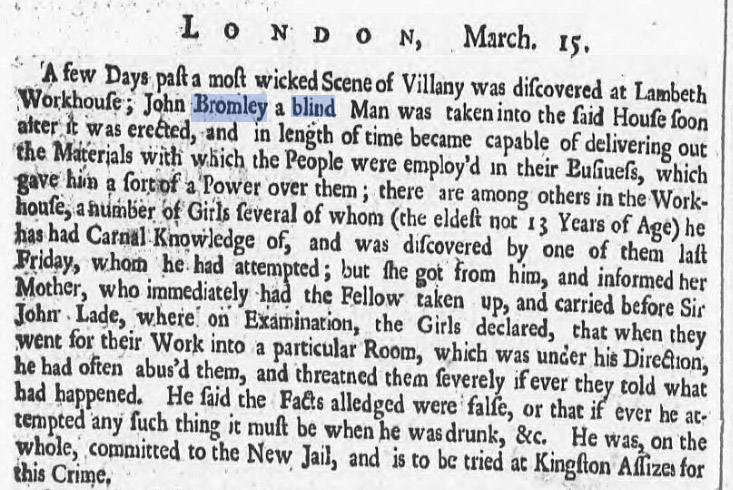 Left: Derby Mercury, 22 March 1738
Left: Derby Mercury, 22 March 1738
The punishment for rape was, of course, death.
But the following week in the same newspaper, we discover that, in an era infamous for severe punishments, the wretch Bromley got off incredibly lightly:
 Left: Derby Mercury, 29 March 1738
Left: Derby Mercury, 29 March 1738
I guess there wasn't enough evidence to convict for all the other offences described by the other girls.
Exactly one year later, we find John Bromley being let out of prison and put in the pillory at Three Coney Walk. This was the final flourish of his penalty: to face his one hour of public humiliation and then be released into the real world:
 Left: Derby Mercury, 05 April 1739
Left: Derby Mercury, 05 April 1739
The story confirms that Bromley was not convicted of rape, but only of assault with intent to rape, and only for one offence, which is why he spent just one year in jail.
Deep breath, and we move on. I'll leave you to make up your own mind about Mr John Bromley.
Lambeth was mostly countryside in the 1700s and I'm quite sure it was a lovely place to live. Trees, fresh air, market gardens.
But, as we all know, newspapers only carry bad news. So we shouldn't get the wrong idea from just two newspaper clippings separated in time by fully 34 years. However, in the next story, of 1773, we learn about another serious crime in Three Coney Walk:


Oooh, nasty.
That's the last mention I found of Three Coney Walk in the British Library Newspaper Archive. It's dated 29 January 1773. The first mention of the name Lambeth Walk is of March 1784, so one may reasonably assume that the name changed between these dates. Why change it? Dunno... Three Coney Walk is a much better name in my opinion.
In Richard Horwood's beautiful map of 1799 we see Lambeth Walk, still surrounded by fields, but with a distinct edge of development along its east side:

By the 1860s, after half a century of overexploitation and population overspill from London, Lambeth was an unrecognisable mess of factories, pollution, ill-health, overcrowded low-cost housing and unsanitary living conditions.
In Edward Webber's map of 1868 we see Lambeth all paved and built upon; the new railway scythes through the middle of the ancient streets; it is elevated by hundreds of brick arches:

In the above map, outlined in yellow, we see the last resting place of Benjamin Partleton (b1799) who died of a stroke in 1843, probably as a consequence of lead poisoning. This is Lambeth Burial Ground; overflowing with bodies and bursting at the seams, it could no longer be used after 1854, and was converted in the 1880s to a children's playground after it fell into neglect. It remains a small park today & is surrounded by some of the headstones which were moved to the perimeter, as we see in the modern photo below.
The Partleton family were poor; I'd be amazed if they could afford an engraved tombstone, so it is unlikely that any of the stones bear Benjamin's name.
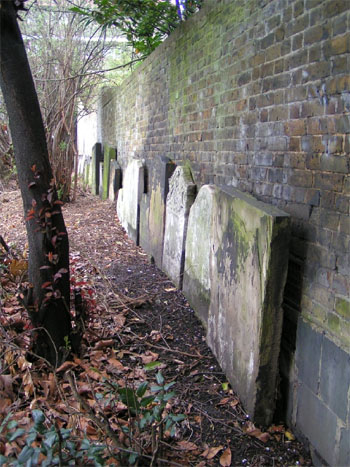 Left: The former
Lambeth Burial Ground
Left: The former
Lambeth Burial Ground
Circled in red in the map below is Union Street where Benjamin's son Charles Greenwood Partleton was living with his uncle & aunt in 1851 after his father's death.

Here's a photo of Lambeth Walk in the 1930s, taken by the Reverend Thomas Tiplady. In the year 1851 it would be a very, very familiar view to my 9-year-old great-great granddad Charles Greenwood Partleton:
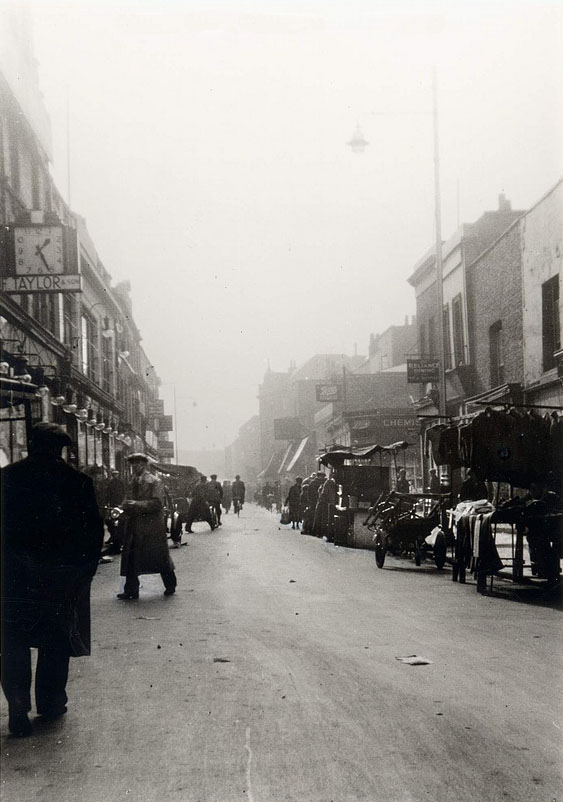
The clock 'F. TAYLOR & SON' at the left of the above picture gives us the clue as to where we are standing.
The picture is taken looking south down Lambeth Walk from its junction with Union Street [aka Fitzalan Street], from the viewpoint of the dark blue arrow in the map:

How do we know where the picture is taken? Because F. Taylor and Son were kind enough to place this advert in 1918:

That shop would certainly be familiar to my great-great granddad, Charles Partleton; it was founded in the 1840s and was there on the corner of his street when he was growing up.
Below we see Charles in the 1851 census, living at 24 Union Street aka Fitzalan Street. He's misspelled as Charles Parselton, and he's living with his uncle and aunt William and Sarah Greenwood, because his dad had died when he was just 1 year old:
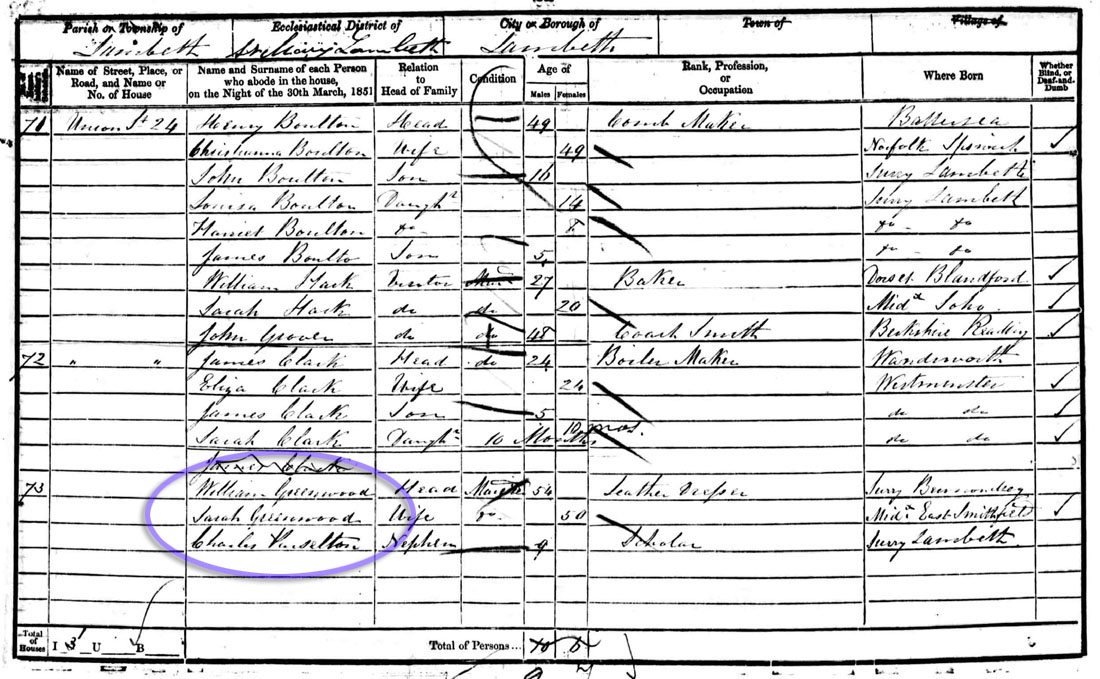
The Victorians knew that London had too many common street names such as Union Street, leading to postal confusion. Consequently, in the 1870s, Union Street was renamed as Fitzalan Street, King Street was renamed as Wake Street, etc etc. None of this helps the family historian, and it makes this page twice as hard to write...
Lambeth Walk would be as completely anonymous as any other street were it not for the fact that it became the title of a tune from a popular stage comedy.
But the famous Lambeth Walk tune would not have been at all familiar to those Lambeth cockney Partletons of the 1800s because it was not written until 1937, by a fellow called Noel Gay (1898-1954) for the musical Me and My Girl.

Here's actor Lupino Lane and the cast at the Victoria Palace, London on 16 December 1937, doin' the Lambeth Walk:
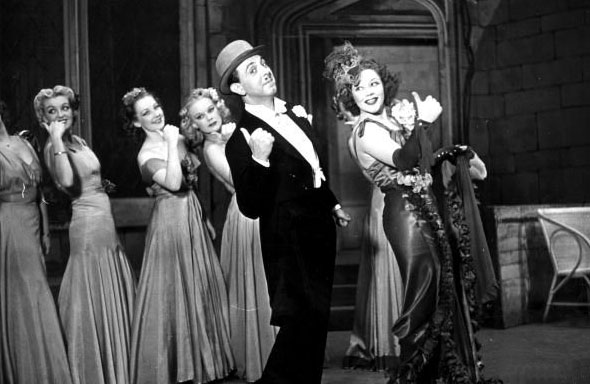
And here we have the cruise ship Strathallan on 03 September 1938. Two cruise girls show a sailor the moves:

And we can bring the Lambeth Walk right home to roost. In 1938, a special appearance was arranged for Lupino Lane to perform the Lambeth Walk in Lambeth Walk! The gigantic public reaction was not foreseen, as we see below, a handful of bobbies struggling to manage a vast crowd on a sunny day in Lambeth Walk:

Unfortunately, it was decided that the situation was not safe for a street-level performance... Lupino Lane did perform, but out of sight of the crowd, on the roof of Taylor's store, as reported by the South London Press:
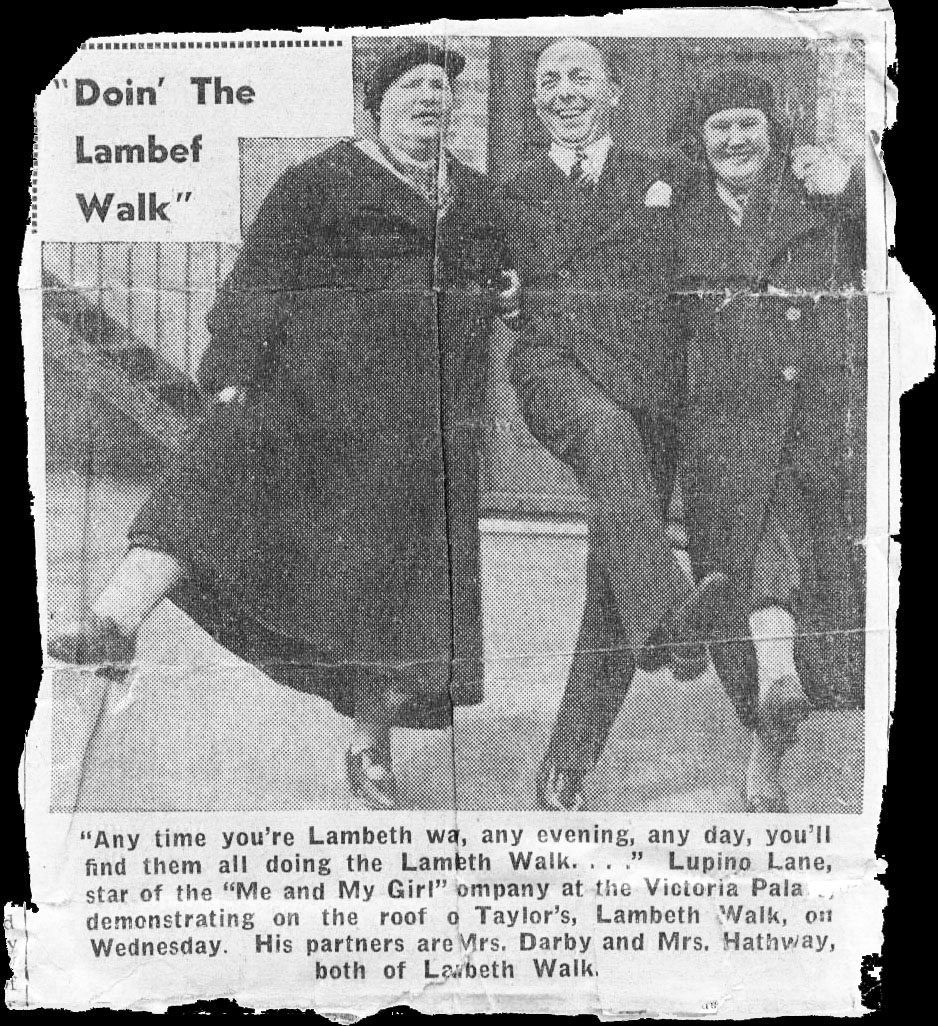
That cutting was sent to the Partleton Tree by Rita Waite whose grandmother, Beatrice Hathaway, is the lady grinning cheerfully at the right of the picture!
For anyone out there who wants to try the steps, just imagine for a moment that you are Dick Van Dyke and follow the dance as illustrated below on the back of the sheet music, complete with cockney stick figures... I love the description "swinging the arms Cockney-fashion". Terry Partleton says he was taught the dance by his sister, my mum Joan Partleton (1928-2003):

Below we see two dancers performing the Lambeth Walk...
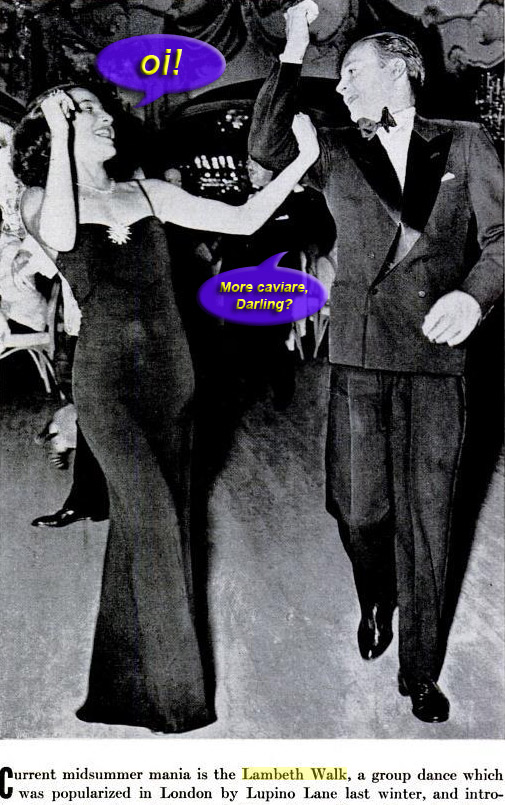
... If you think the revellers look a bit too posh for Lambeth, you'd be right. They are Americans. The clip is from Life magazine of 27 August 1938 as part of an article celebrating the Lambeth Walk dance craze in the USA. I confess I added the speech bubbles myself.
And if you are not sure you know this cheery tune - but I can assure you that everyone does - we have a treat in a moment & you’ll have the opportunity to hear it, but before that I need to set the scene.
Pre-war Nazi Germany - and specifically its Propaganda Minister Joseph Goebbels - didn’t like the Lambeth Walk, as described in the book High Society in the Third Reich by Fabrice D'Almeida:
Two years later - WW2 still hasn’t started - but on 07 January 1939, a New York Times reporter wired home one of the many alarming reports of the paranoia, intrusiveness, intolerance and sheer terrifying, nauseating, bewildering insanity of events proceeding in Germany:


Moving along two further years - we have now jumped into the middle of WW2, - and the Nazis in Europe are on the crest of their wave. On 12 January 1941 Goebbels wrote an article 'Aus Churchills Lügenfabrik' [Churchill’s Lie Factory] for a National Socialist publication Die Zeit ohne Beispiel, accusing the British of using propaganda to support their war effort. Nazis seem to have no sense of irony – Goebbels official job title is Minister of Propaganda! Anyhoo, in this article Herr Goebbels’ dislike for the Lambeth Walk surfaces:
'They [ie the British public as portrayed in newsreels] appear to have nothing better to do than to raise the British flag amidst the smoking ruins, or to dance the Lambeth Walk in the middle of the scorched walls, cheering the king as he goes by.'
 Left: Joseph Goebbels
Left: Joseph Goebbels
So imagine Hitler’s and Goebbels’ reaction, one year later, to this comedy short film, a piece of genius which synchronized images of goose-stepping Nazis with the tune of the Lambeth Walk. It became very popular in cinemas in Britain and America in 1942. Click below and imagine the laughter in wartime cinemas. I've watched this little masterpiece a dozen times while I created this web page, and I've laughed every time. No doubt it will already be familiar to some:
Actually we don’t need to imagine Joseph Goebbels’ reaction to this piece of gentle fun ridiculing his loathsome goose-stepping stormtroopers. The story is that Goebbels stalked out off the screening room swearing and kicking chairs on his way out.
Credit for this small act of genius goes to Charles Ridley of the British Ministry of Information who edited the film and distributed it free to U.S. and British newsreel companies who added their own narratives. Consequently there are several versions.
In December 2010, the Partleton Tree was contacted by Charles Ridley's great-niece, Jane Smith:
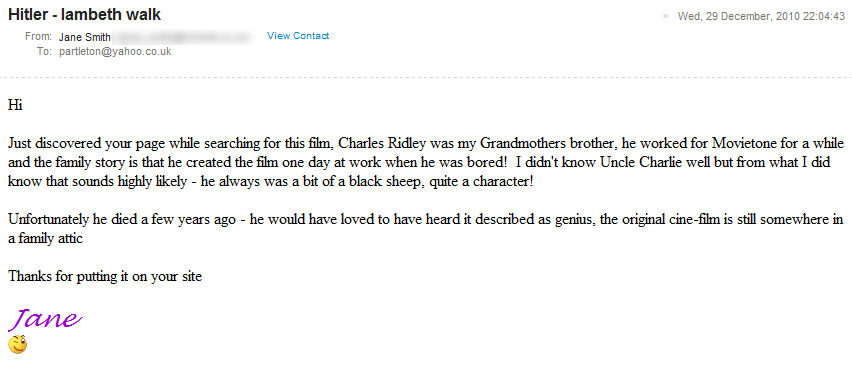
In the next photo we see shoppers in Lambeth Walk doing their bit for the British war effort. A collection box to help pay for a Spitfire!

Joseph Goebbels would look you straight in the eye and declare that the above picture is a lie, a war publicity stunt, a product of Churchill’s Lie Factory - to put it bluntly, propaganda, to use that uneuphonious word - and though that's true, the money in that box did actually go into the overall fund for the Borough of Lambeth, and an actual Spitfire was paid for - at least in part - by the collection. And when it was built, that Spitfire did shoot actual bullets at German planes. It was given the serial number P8088, and we see a photograph of it in 1941 below.
With the eye of faith, we may discern the name 'The Borough of Lambeth' painted on the fuselage above the wing:

The plane saw action in dogfights in May 1941, and, as well as flying on defensive duties on the south coast, was also extensively used for training. But survival rates for fighter aircraft in WWII were very low, and we should not expect a happy ending. P8088 crashed, pranged, and was repaired more than once during its training operations. On 16 September 1944 it dived into ground at Lower Heath Coppice, Prees, Shropshire, and its young Australian pilot, Flight Sergeant John Cashel Barry of the RAAF, aged 22, died.
Some of the severely damaged remains of the aircraft were salvaged for scrap during WW2 and held in store: some parts survived the war, some more bits were recovered from the crash site in 1978, and the cockpit has been restored in recent years.
Lambeth was regularly struck by the Luftwaffe as can be seen in the photograph below of Lambeth Walk in September 1940:

Business-as-usual proceeds in the street, overlooked by a picture incongruously still hanging on the wall of the bombed-out building.
The building at the end of Wake Street which we see in the picture below is Lollard Street school, which was destroyed by bombing, along with a few of the houses at the far end of Wake Street:

The photograph above was taken from the viewpoint of the red arrow in the map below:

The bombed-out remains of Lollard Street school were converted to an adventure playground post-WW2.
In the photgraph below, we see 1950s schoolkids having fun among the rubble of the legitimised bombsite/playground at Lollard Street...
Those of our gentle readers of a nervous health-and-safety disposition should look away now as chlidren light fires, step on nails...
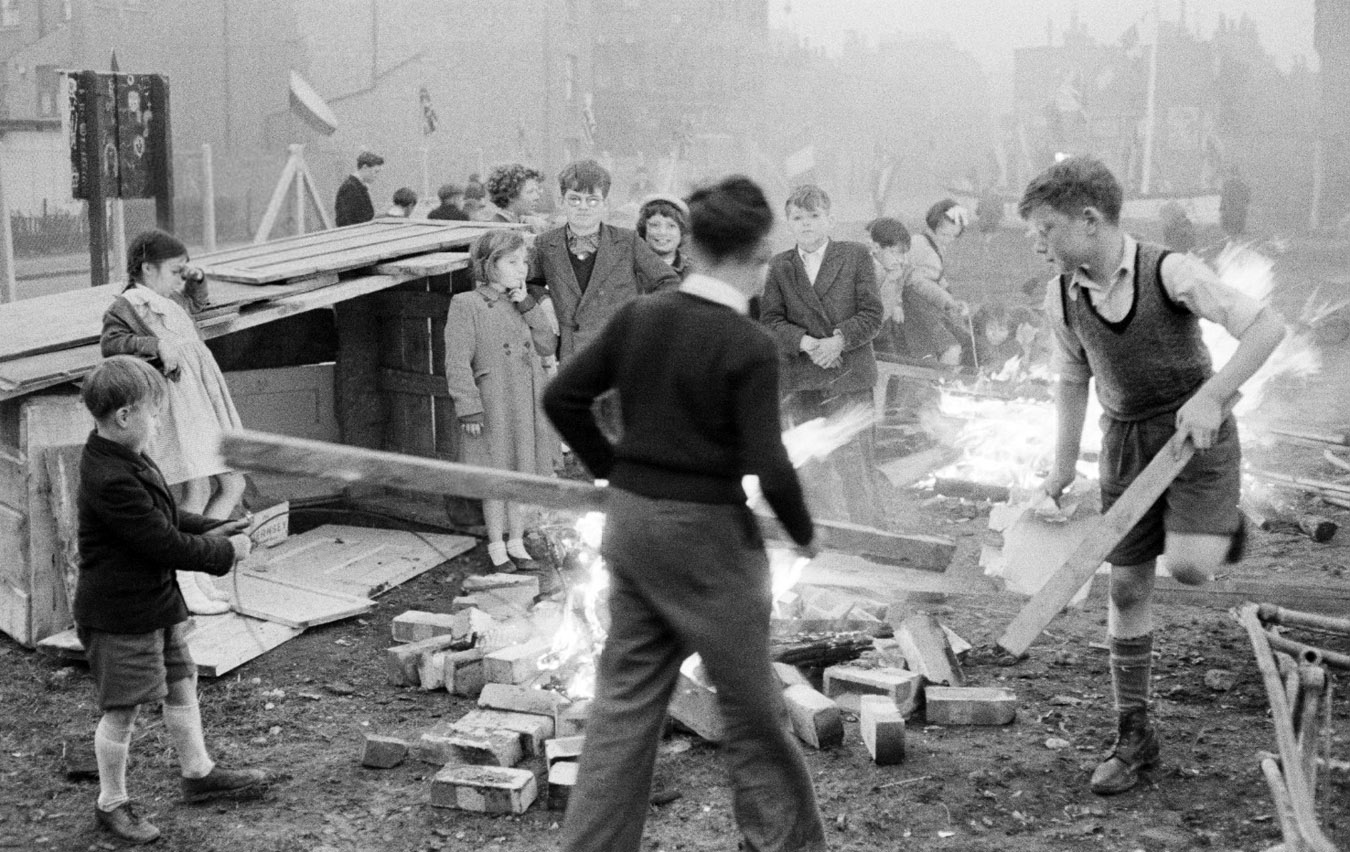
... and wield pickaxes...
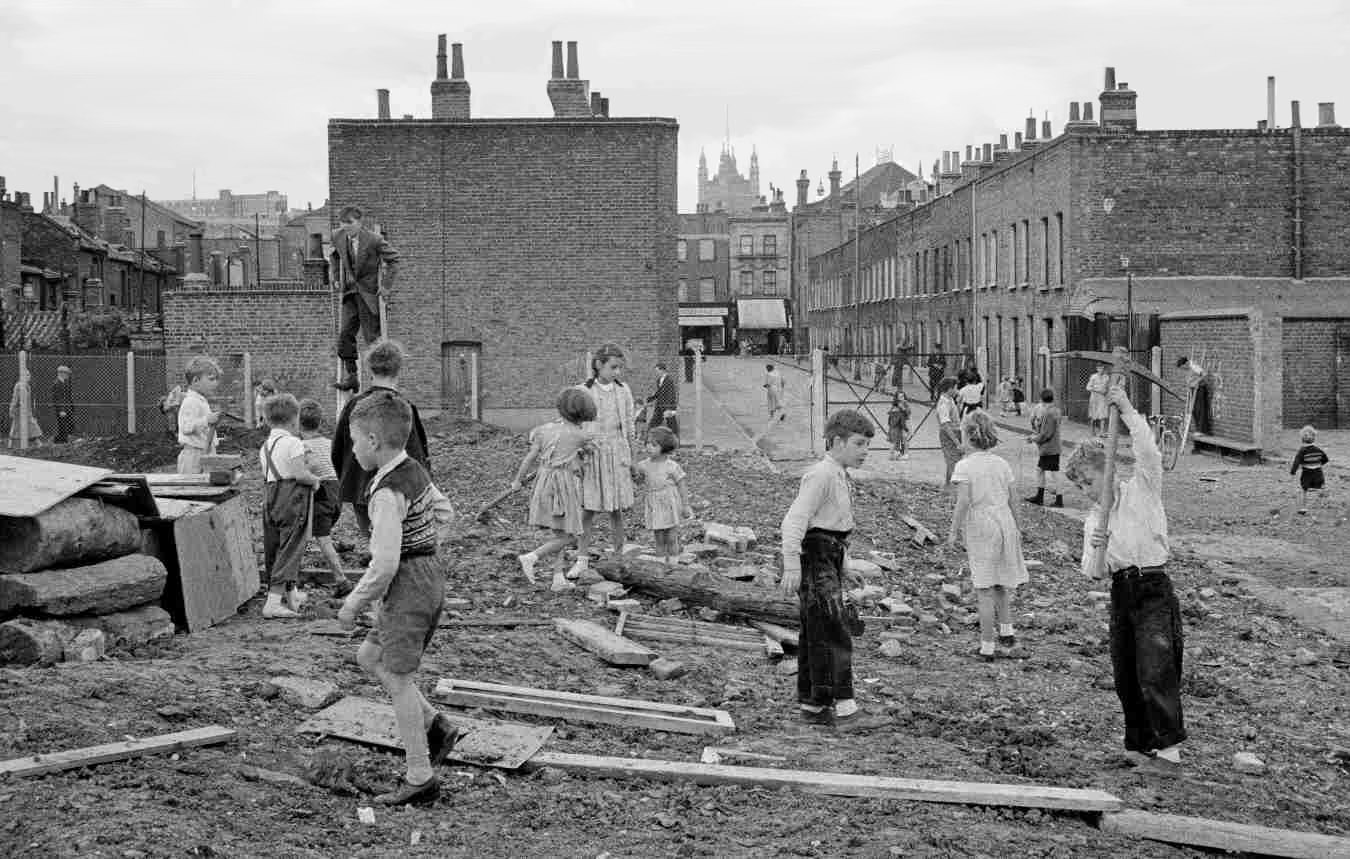
It looks like a lot of fun.
The spires on the horizon at the end of Wake Street in the picture above are those of the Houses of Parliament.
The photograph was taken from the viewpoint of the pink arrow in the map below:

My own recollection is that all bombsites - some of which still persisted into the 1960s when I was a kid - were used as playgrounds. The Lollard Street site, which we see below left in 1954...
xxxxx

...was supersvised, but the vast majority, of course, weren't. It is still there, as we see above on the right, but is presently [2013] 'temporarily closed' - whatever that means - according to Lambeth Council's website.
Anyhoo, where were we? Ah, yes, that's right - Lambeth being bombed in WW2...
Here's a young woman being rescued at an unidentified location in Lambeth in 1944:

One year later, May 1945... On 01 May, Joseph Goebbels didn't have to endure the Lambeth Walk any longer because he killed himself (and his own six small children) in Hitler’s bunker. Below we see Goebbels and his wife with their children a year or two before they murdered them:
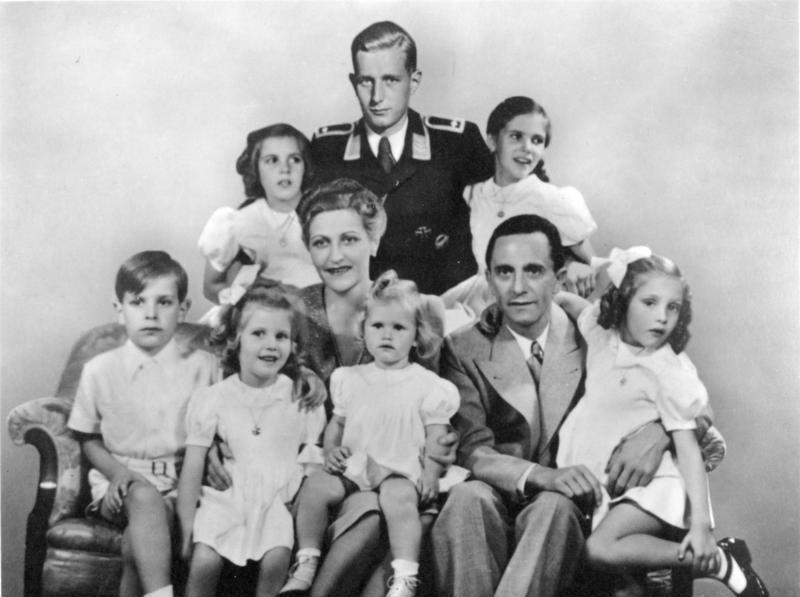
Seven days later, on 08 May 1945, Germany surrendered. And on 12 May, the ordinary people of Wake Street, formerly King Street, Lambeth Walk, after 5 years of enduring Hitler's bombs, rationing, sheltering in tube stations, deaths of family members and other hardships, can organise a VE-day party for the children of the street to celebrate the end of the war in Europe and the downfall of the Third Reich!:
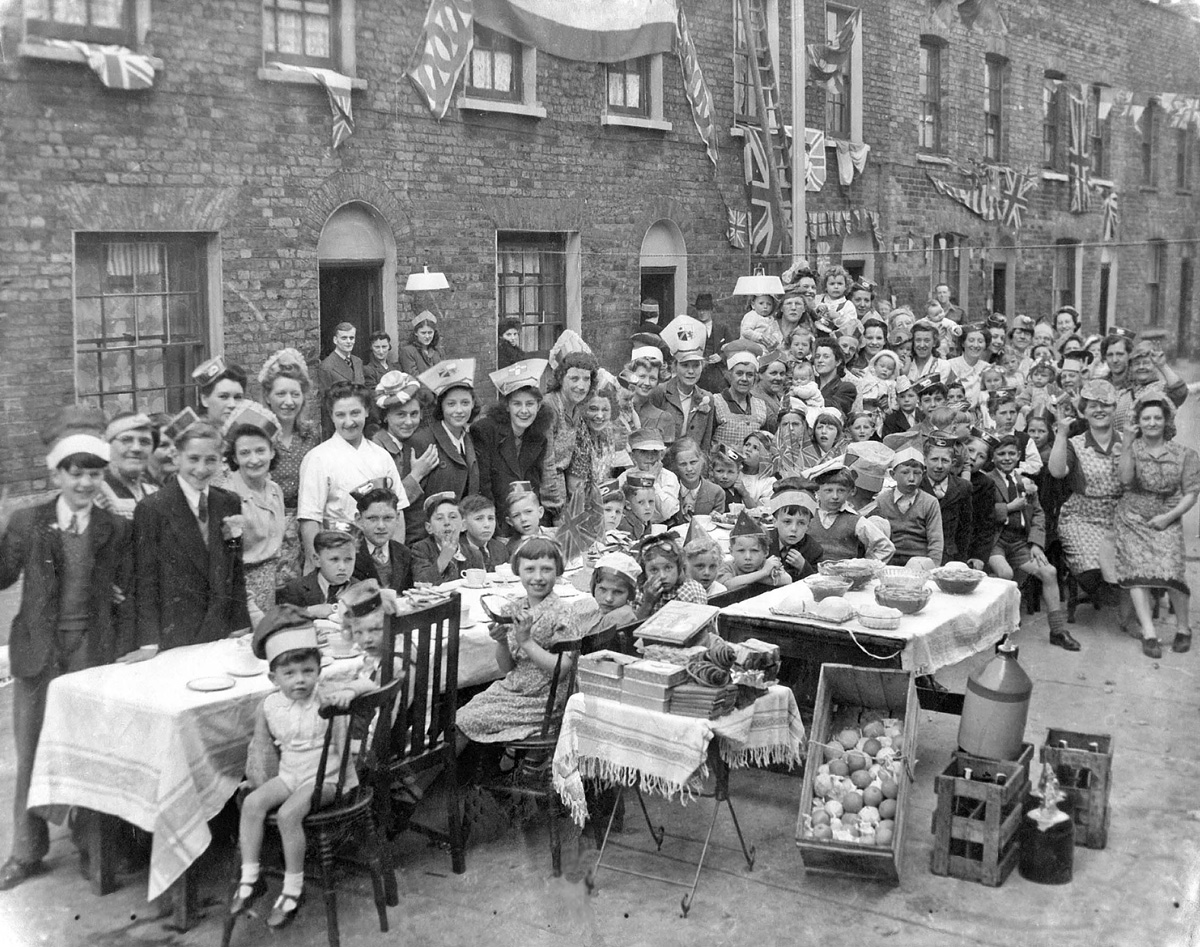
The faces in these pictures all tell a story. The few luxury goods available have been gathered for the party, but that's scarcely the point... the war is over.
In July 2010, we received an email from Joy Russell, whose mum is in the picture aged 19 years old, and sent us the lovely hi-res copy of the photo we see above:

Joy mentions Alfred Swetman and Martha Tyler, of whom we will hear in a minute.
In June 2011 the Partleton Tree received an email from Keith & Laraine Clark who fill in come more names from the party picture, and I repeat the picture below for anyone who wants to match up the names:


The picture of the street party is taken from the viewpoint of the green arrow in the map below:

In June 2013 we had some further identification of people in the VE Day picture, from Partleton Tree correspondent Janet Rose:

To match Janet's email, I have zoomed in below, among the young mums at the back of the photo. That's Lil Collins with her baby Brenda at the yellow arrow below, and Lylie Wheeble with her baby Beryl at the green arrow. Of course, it's only women and children in the picture; all the young men are still at war:

I strive to be chronological in the Partleton Tree as I feel without this, the narrative becomes disjointed and the gentle readers may lose their normally happy countenance, but it is necessary here to rewind a little back to the 1930s.
Fortunately for us, the fame generated by the musical prompted the magazine Picture Post to send a photographer down Lambeth way to capture some images for their edition of 31 December 1938, and the result is that we get a little insight into the Lambeth of old. These pictures were taken in the 1930s, but I'm sure they might equally have been taken in the 1830s...
The first picture is taken in Wake Street, the side-road off Lambeth Walk which we saw above:

This picture is taken from the viewpoint of the red arrow in the map below.
It is extraordinary how much information can be yielded: we were emailed in February 2010 by Tony Swetman whose dad (b1926) Alf had lived in Wake Street. So, let's hear what he has to say about the above picture:
'In this photo the man smoking the pipe is the granddad of my father (Alfred Swetman, born 9/3/1926) and his name is William Swetman (born 9/9/1867). He lived at 6 Wake Street. The woman on the left is Mrs McCarthy who lived at 47 Wake Street. The accordion player and the dancer are itinerant buskers.'
And another observation of the above photo comes from Joy Russell's mum, a childhood friend of Alf Swetman, born in the same year:

If you are puzzled about the street names; a reminder that Wake Street was originally called King Street in Victorian times:

Picture Post claimed that the old codger busking in the picture in Wake Street was 'Doin' the Lambeth Walk' but since the photo was taken in 1938, this is unlikely unless he was at the cutting edge of new trends.
The next picture is a doorstep on King Street / Wake Street. Which doorstep? Ah, well, you have me there. I don't know... but Alf Swetman does:
'The woman scrubbing the step below is Mrs Pease who lived at 44 Wake Street.'

What was achieved by the scrubbing of the doorstep? Don't ask me. Certainly dog wee on your hands. But if you were working class, and you wanted to maintain your family's reputation in 1938, you had to do it.
OK, I am editorialising again. Lets move on.
The next two marvellous pictures are taken in an eel-and-pie saloon on Lambeth Walk, 1938. The poster on the wall 'Rag Time Dance' dates the photo exactly; November 19th falls on a Saturday in 1938:

Another picture below; two young mums have a few bob spare to treat their kids to a meal out; all look well:
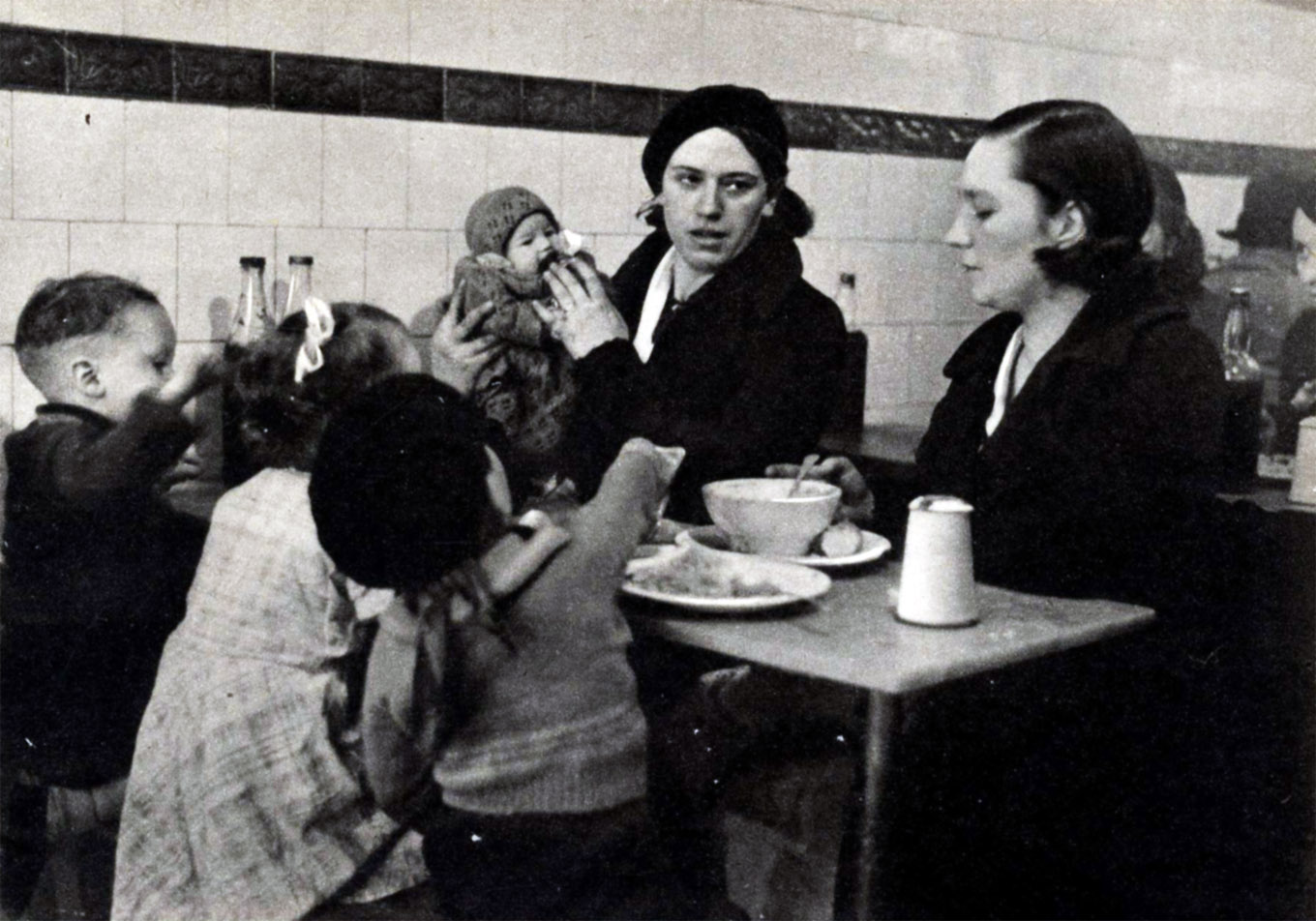
We learn from Partleton Tree correspondent Terry Simpson that the pie and mash shop was called Harringtons...

Apparently this is close, but not correct, according to Alf Swetman:
'... the email from gives the name of the pie shop as Harringtons - this is incorrect. It was Burroughs. The Harringtons pie shop was actually in South Lambeth Road.'
The pub mentioned by Terry is The Feathers, making its reappearance on this page. We may remind ourselves that it is located on the junction of Lambeth Walk and Paradise Street, outlined in purple on the map:

Paradise Street seems an ironic name amongst the urban grime and poverty of Lambeth, but it is a survivor of earlier times; it can be seen on those old maps when Lambeth was just a village. Anyway, I digress... let's step into The Feathers for a pint on that smoggy 1938 evening:

Well, if we are forced to comment, it looks rough. Very rough. No beauty contest. But what a great atmospheric photo. And we can get closer to one of these people with the help of Tony Swetman; step into their shoes...
'In the photo above, the man stroking his chin is "Mousey" Britchford-Steel. My Father never knew his first name. Mousey was married to a woman called Martha Tyler who ran a greengrocery stall in Lambeth Walk right outside the Feathers pub.'
In June 2011 the Partleton Tree received an email from Keith & Laraine Clark who can provide some more identification:

And it seems a good place to show another picture taken in an unnamed courtyard off Lambeth Walk in the 1920s, another photo taken by the Reverend Thomas Tiplady. Two Lambeth ladies standing outside their residence. No mistaking the poverty here:

Poverty, of course, can't suppress the human spirit as we see in the next picture taken in Lambeth Walk in the 1938, entitled 'A Crowd Looks on as Miss Dipper Does the Lambeth Walk with Billy Pease the Peanut and Toffee King'. Photographs just don't come better than this one. Just look at those faces in the crowd...

'Martha Tyler is the woman right in the middle of the photo above with her arm raised into a fist. The man dancing with Miss Dipper is Billy Pease (who was the father-in-law of the woman scrubbing the step).'
In December 2013, the Partleton Tree received an email from Billy Pease' granddaughter Alice:

Below we see Alice's photograph. Her granddad Billy is at the left:
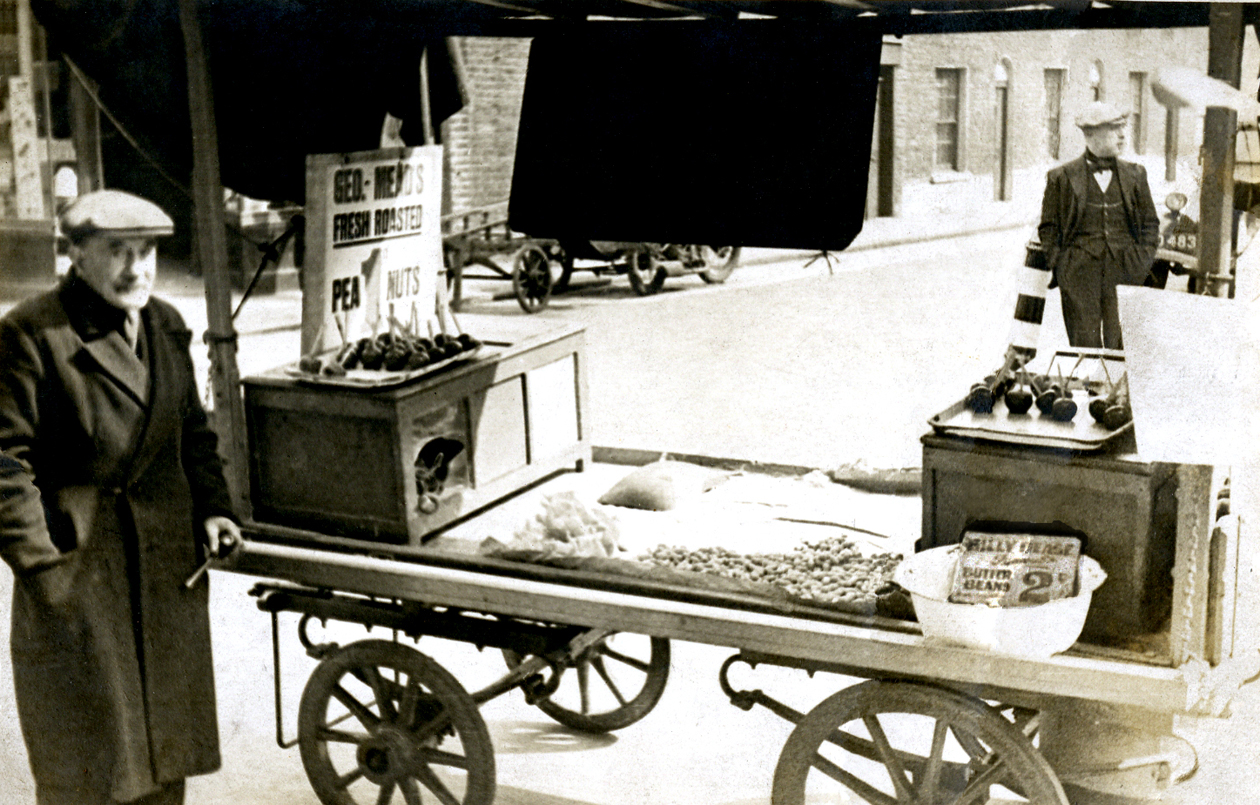
The side road behind Billy's pitch is yet again Wake Street / King Street.
It would be familiar view to Charles Partleton (1839-1916) and his family because in 1871 they lived in this very road, at number 43:

The photo is taken from the orange arrow:

Here's the same junction in the 1950s. The side road in view is Wake Street / King Street. Zains Radios have changed their sign from M. Zains to A. Zains and have extended their stock to include televisions...

At the right of the above picture we see mannequins in the shop window, and in January 2011, the Partleton Tree received the following email from Brenda Peters. Brenda tells us that she worked in this shop (Sadie's Fashions) in the early 1960s:
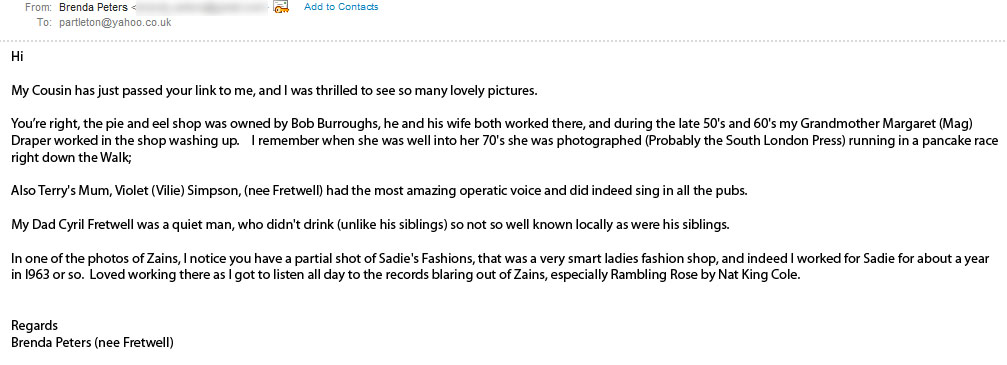
And here's the unassuming frontage of Burroughs eel and pie shop in 1965:

Also in 1965, here's an external view of The Feathers:
 xx
xx
That picture was from the viewpoint of the purple arrow in the map below. On the right we see the same corner in 2009, thanks to the miraculous Google Street View. I think we can sense the ghosts of the old pub; the boozing; the singing; the fights.

And we can get another look inside the The Feathers, thanks to Alice Bracey whose dad Bill Watts worked in the pub in the late 50s and early 60s:
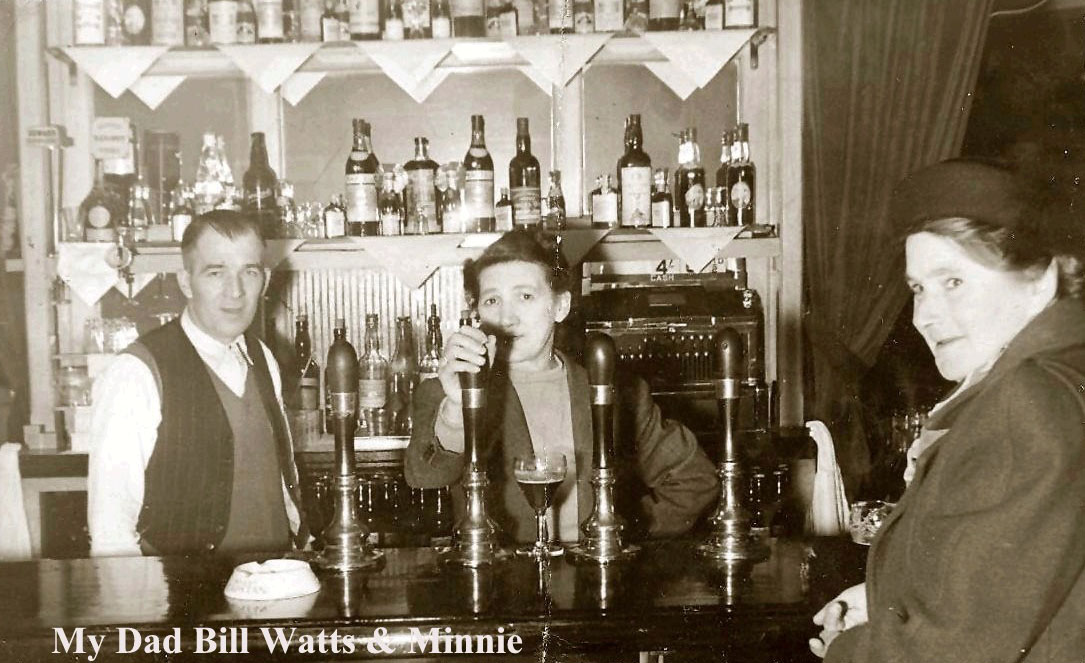
Alice found the Partleton Tree website and kindly sent us some great pictures. In the photo above we see Alice's dad Bill, and Bill's sister-in-law Minnie, who was the landlady. I really like the cost of the last round still rung up on the till... four and sixpence ha'penny.
The landlord was Minnie's husband Alf. If you wanted to create any trouble in the pub, you might think twice; Alf was London boxing champion:

In January 2010, The Partleton Tree received an email from Tom Terry. Tom attached the following stunning photograph taken in The Feathers on 08 May 1945:

Tom's dad, also called Tom Terry - the landlord of The Feathers in 1945 - is the man at the far right behind the bar. And if you think everyone looks rather cheerful, and there's plenty of brown-ale been downed on the bar, it's because the 8th of May 1845, as you may remember from earlier on this web page, was Victory in Europe (VE) day. Hence the pictures of Allies Winston Churchill and Joe Stalin behind the bar... I reckon the picture frame just out of shot has to be Franklin Roosevelt!
There was a short BBC radio broadcast from the bar on the night. Ninety-nine days later, on the very last day of the war - VJ Day - Tom Terry Jr was born in The Feathers!
In January 2012 The Partleton Tree received this email from Mike Reynolds:

Here's Mike's picture:

I really like the genuine look of glee and excitement evident in the kids' faces.
In the photo above, we can just see The Feathers on the right. It is taken from the viewpoint of the blue arrow in the map below:

Also in January 2010, The Partleton Tree received an email from George Fallon whose dad, in the 1930s, purchased the silver tankard below.

It was intended as a best-man gift but he liked it so much, he decided to keep it, and later passed it on to his son! It may not appear stylistically Victorian but it has 'VR' engraved on the back which we can only assume makes it firmly Victorian, and in any case, whatever its date, it must surely have had pride of place behind the bar at the Feathers!
And while we are on the subject of Partleton Tree correspondents, we had an email from Alex Hewett with a nice anecdote about the old way of life:

Here's a view of the back of some of the Lambeth Walk shops. No, this is not another one of those Victorian pictures which abound on this website; this one was also taken in 1965! Note the TV aerials.
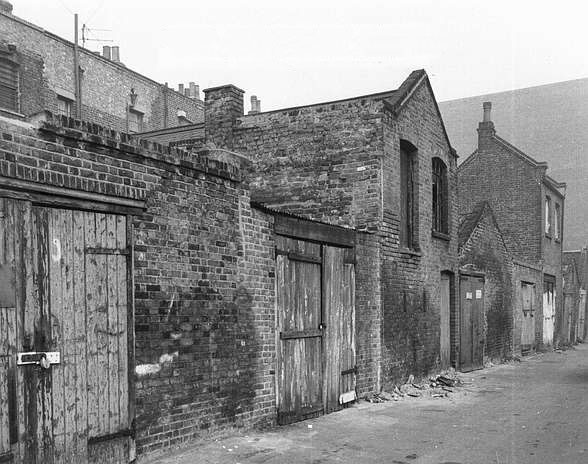
Lambeth Walk suffered major bomb damage on September 8 1940. Below we see a picture taken 16 years later in 1956. A chappie with his shopping from the viewpoint of the yellow arrow. A bombsite is still there, visible in the background, covered by temporary advertising billboards.
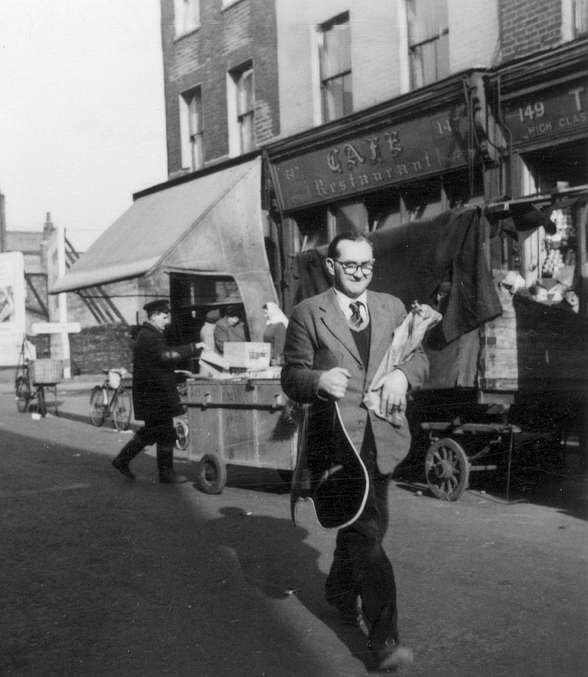
Last old picture, Lambeth Walk, 1956:

The photo is from the viewpoint of the turquoise arrow below:

Post-war, Lambeth Walk has been redeveloped more than once and is now mostly unrecognisable from the photographs we saw earlier.
Below is a photograph of how Lambeth Walk looks today; rather characterless but at least cleared of slums:
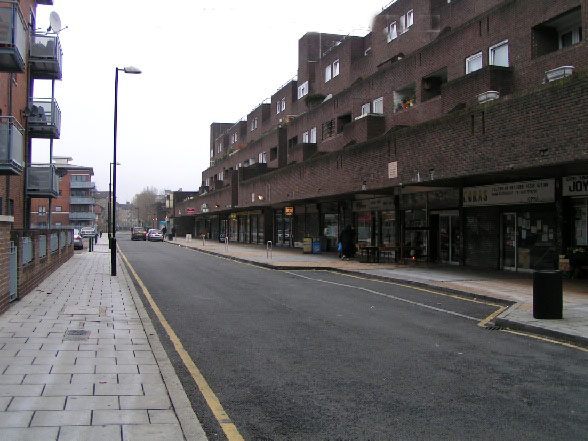
In March 2012 the Partleton Tree received the following email from correspondent Lin Bowen, so I'll end this page with a little appeal...

This email refers to the beautiful photograph of circa 1921 we see below:
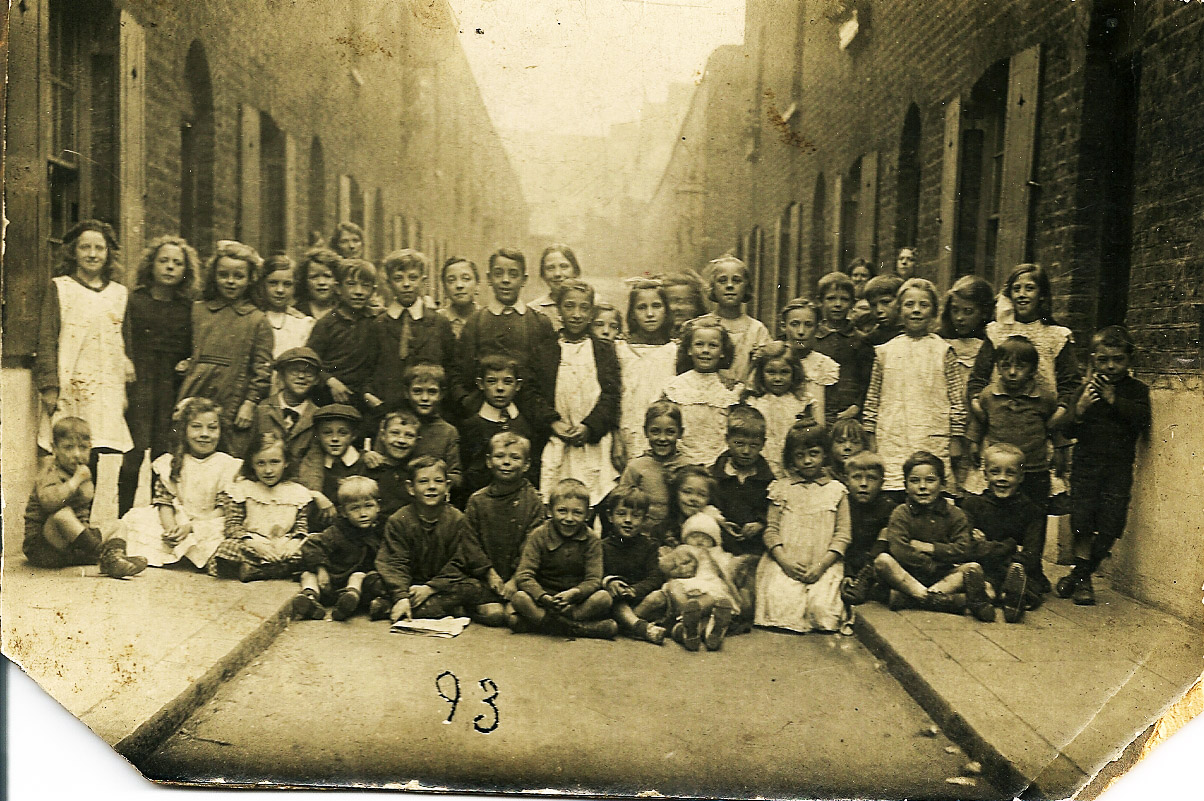
In the photograph we see Linda's mum Maud Clark. Maud, who passed away aged 92 in 2002, is picked out in the picture below along with her brothers Frank and Charles, and her sister Lillian. Does anyone recognise any of the other faces?

In March 2014, the Partleton Tree was contacted by Christine Ebdon who was amazed to find her mother Ellen Mead in the photograph. Christine kindly furnished the names of Ellen's brothers William and Patrick and sisters Emily and Elizabeth Mead.

The picture was taken in Walnut Tree Place, circled in blue below:
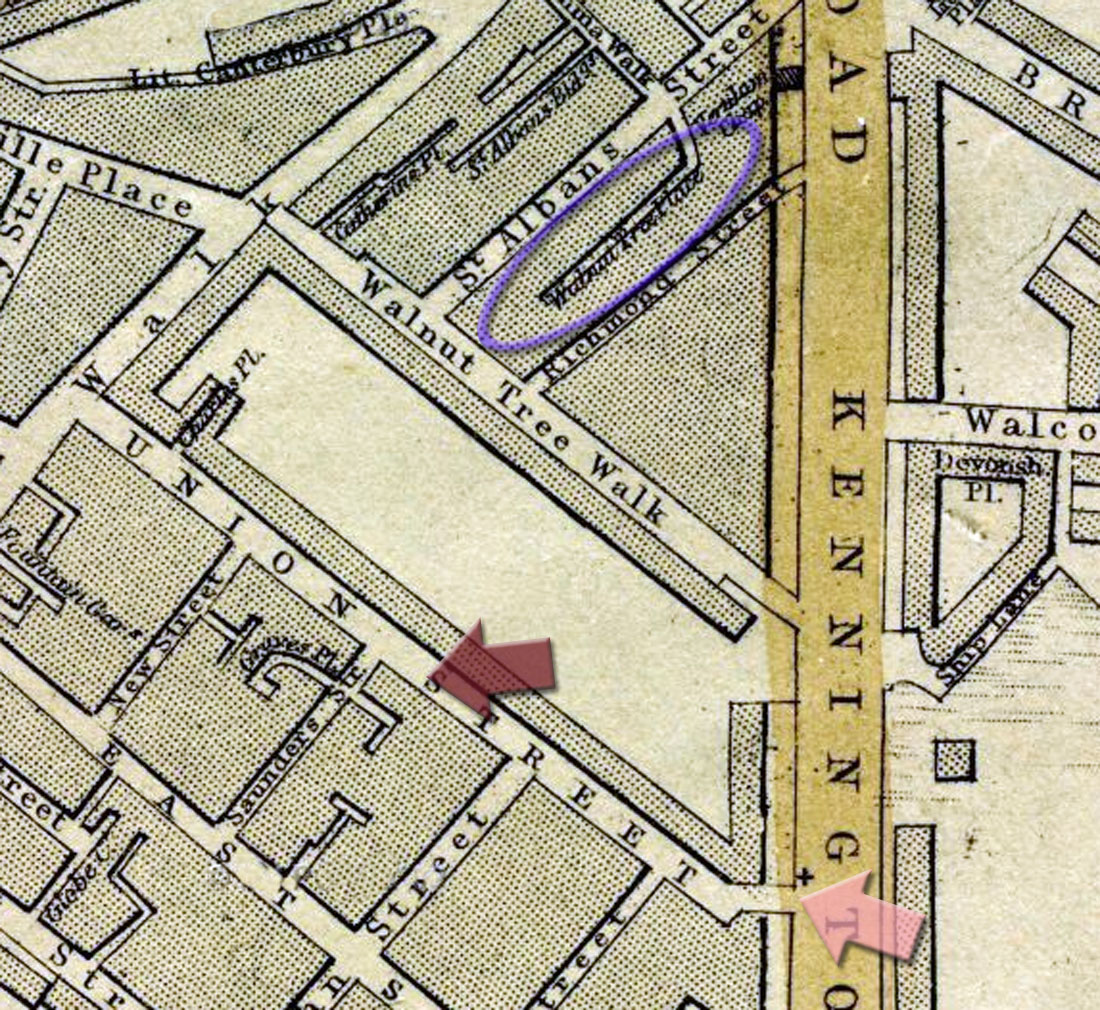
Christine also sent us the lovely family photograph below, taken in 1921, again in Walnut Tree Place, a location recognisable by the distinctive shutters on the windows:

Pictured above is Christine's grandmother Hannah Mead nee Davies with four of her children. The children are Christine's mum Ellen Mead with her hands on her brother Patrick Mead's shoulders, Emily Mead in the middle and Elizabeth Mead on the right.
We get quite a bit of correspondence about this page... to read a selection of these interesting emails, click here.
If you enjoyed reading this page, you are invited to 'Like' us on Facebook. Or click on the Twitter button and follow us, and we'll let you know whenever a new page is added to the Partleton Tree:
Do YOU know any more to add to this web page?... or would you like to discuss any of the history... or if you have any observations or comments... all information is always welcome so why not send us an email to partleton@yahoo.co.uk
Click here to return to the Partleton Tree 'In Their Shoes' Page.
